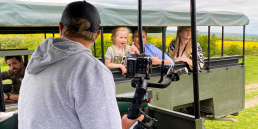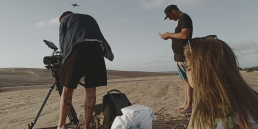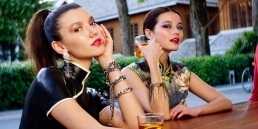The Coronavirus pandemic drastically changed the way many industries operate, and at the beginning of lockdown it became impossible for any production to shoot. However, as the restrictions have started to be lifted, we’re happy to announce that our team has finally returned to set, welcome to the new normal!
Our post covid return
With new protocols and procedures to follow, we thought it would be a good idea to give these a dry run so we can work out any issues or refinements before returning to a commercial set. To do this we set up a three day shoot showcasing the beautiful Beltingham House in Northumberland. In this production we followed a couple throughout their countryside getaway whilst showcasing a luxurious stay in this stunning country house. We were also fortunate enough to partner with Barbour and Cotswolds Distillery – as sponsors they provided some signature products which greatly aided in bringing the piece to life.
With a reduced crew size of 3, plus two models, we all had to adapt the way we work to be “Covid compliant”, ensuring the safety of everyone on set and meet government guidelines. Moreover, as this was our first time returning to set, these measures saw more extensive pre-production requirements.
Safe sets International
All crew members completed the ‘Safe Sets International’ certification, allowing them to understand the virus and discover the new protocols for production, to ensure the well-being of everyone on set.
This certification allowed an understanding of the early warning signs of the virus, who is most at risk and how it can spread. It also informs on the practical ways to prevent contamination on set — such as, all crew members had their own two-way radios that they alone were responsible for, preventing cross contamination.
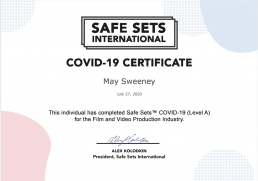
Arranging production schedules to reduce the amount of people on set at all times. As well as the stringent use of recommended PPE and there availability throughout the various shooting locations.
In addition to this, all crew were sent a health and travel questionnaires prior to the shoot to ensure they were all fit for work, and then checked on the day before to make sure their health was still in top condition. If any members would have reported any symptoms they would have been removed from the shoot. Thankfully nobody did.
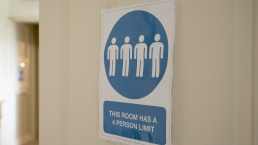
Further safety precautions
To ensure the safety of all those involved, instructional signs were placed throughout the set, reminding all crew and talent of the key ways to stay safe. Moreover, social distancing was strictly enforced – during the recce we were able to assess how many crew members could be in each room whilst keeping to social distancing, and writing the scenes accordingly.
We also created one way systems and signposted these along with the people per room limits to enforce social distancing.
Designated sanitising stations were positioned at the entrance of the set, as well as the areas that generated the most traffic, to encourage regular cleaning. Disposable masks and gloves were also placed throughout, ensuring all crew had access at all times. Although it took time to get into a rhythm of regularly utilising these tools it soon became second nature and the crew reminded each other to keep on top of these measures.
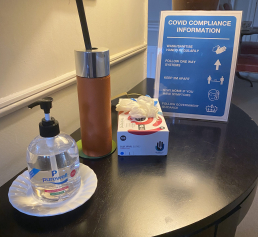
The challenges
Hair and make up posed their own challenges. As at the time, we could not have a hair and makeup artist on set, we made sure the models could do their own ensuring it was a zero contact shoot. We also arranged hair and make up consultations via Zoom prior to the shoot, with dry runs and instructional videos to keep their memories fresh. This required a certain level of trust in the talent, and they did an amazing job.
However, touch ups are often required on set, and without mirrors it can be hard to correct what needs changing. Sometimes there can be a single hair out of place, or an item of clothing bunching in one area; so we had to ensure our communication skills were at their best to tell them exactly where it was and how to fix it.
Although we were prepared, it’s safe to say it took some time to get used to this new way of working. Even from the writing stage we had to exclude scenes that involved any contact – such as cosy moments between the couple, and opt for camera trickery and cleaver cuts to give that illusion instead.
Throughout the shoot, small things like not being able to hand over a fresh battery posed speed and logistical challenges. With a reduced crew it meant cross-contamination was easier to manage, but simply sticking to one person handling all equipment created it own issues with the additional downtime it produced. Furthermore, eliminating any physical interactions with the models (such as not being able to fold down a collar or wipe away smudged makeup) was new territory. For such a hands on team we really had to learn to be hands off.
The result
We took this all in our stride and it ended up becoming a valuable learning experience for future shoots. Now we know how extensive we need to be in pre-production, especially when prepping the models. Moreover, we also understand that scenes will need to be rethought to ensure social distancing and the safety of everyone on set.
However, I think what stands out most is that this new way of working doesn’t have to impact the quality of our work. Yes, it was more challenging, and more time consuming, nevertheless the final product is still a beautiful film that we are proud to put our names to.
Take a look at the final piece here.
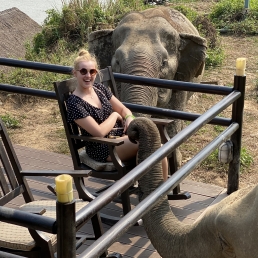
May Sweeney
Marketing Executive
Related Posts
June 4, 2023
8 things you should know before filming with animals
With the advent of social media, and…
